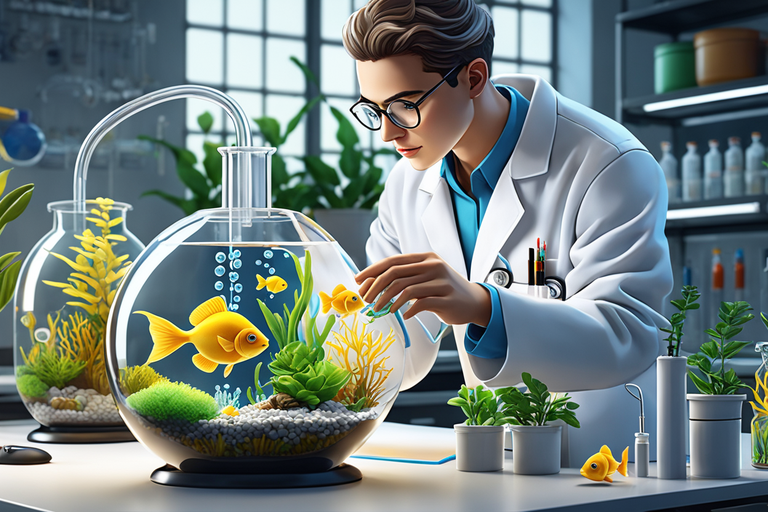Are you an aquarium enthusiast looking for the best way to keep your fish healthy? Setting up a hospital tank is an essential step. Not only can it help you provide individualized treatment and protect healthy fish, but it can also make your aquarium maintenance easier.
In this guide, you’ll learn how to set up and maintain a hospital tank to keep your aquarium thriving. Read on to get all the information you need to keep your fish happy and healthy.
Benefits of a Hospital Tank

You’ll quickly realize the benefits of having a hospital tank when you need to quarantine sick fish from healthy ones. Setting up a hospital tank can help stop the spread of diseases, provide individualized treatment, and protect fish from bullying.
When it comes to hospital tank setup, mimic the conditions of the main tank, but opt for a bare-bottom tank design for easy cleaning. Stable temperature and high water quality are essential for the hospital tank, and a sponge filter is recommended for gentle filtration. Regular water changes are also necessary without chemical filtration.

Main benefits of the hospital tanks are:
- Disease Prevention and Containment: A hospital tank acts as a barrier, effectively preventing the spread of infections and diseases among the aquarium community. By isolating ailing fish, you ensure disease containment and protect the health of other fish.
- Tailored Treatment and Fish Care: The hospital tank allows for specific and targeted treatments, ensuring that each fish receives individualized care. This is especially crucial when administering medications that might not be suitable for all aquatic inhabitants.
- Protection from Bullying: In the main aquarium, sick or injured fish can become targets for aggression. The hospital tank offers a refuge, shielding them from potential bullying and further stress.
- High-Quality Water and Disease Control: With a dedicated setup, maintaining optimal water quality in a hospital tank becomes more manageable. This environment is vital for the recovery of sick fish and effective disease control.
- Aquarium Health and Fish Recovery: By using a hospital tank, you safeguard the overall health of your main aquarium. After treatment, fish have a better chance of recovery in this controlled environment before reintroducing them to the community.
When do you need a Hospital Tank?
Determining the need of a hospital tank is important. Observing your fishes for any physical or other signs is essential to prevent the disease to spread. Below is a list of common diseases and their signs (in berief) in aquariums.
Ichthyophthirius multifiliis (Ich or White Spot Disease): This is a highly contagious parasitic disease, marked by white, salt-like granules on the skin, fins, and gills of fish. It’s often introduced into an aquarium by new fish or plants that haven’t been properly quarantined. The life cycle of the parasite makes treatment in the main tank difficult, as medication needs to target the free-swimming stage.
This disease manifests with small, white cysts that resemble grains of salt on the fish’s skin and gills. Infected fish may scratch against objects due to irritation. Rapid breathing and lethargy are also common signs.
Fin and Tail Rot: Bacterial infections can lead to the deterioration of a fish’s fin or tail, resulting in a ragged appearance. Poor water quality often exacerbates this condition, and treatment with antibiotics is usually more effective in the isolated environment of a hospital tank.
Look for fraying or disintegrating fins and tails, often with a red or white edge. The affected areas may appear milky or bloody. Fish may become less active and show signs of stress.
Velvet Disease (Oodinium): Caused by dinoflagellate parasites, this disease presents as a yellowish dust on the fish’s body. It’s particularly deadly and can spread rapidly through the water. Quarantine and treatment with copper-based medications are often required.
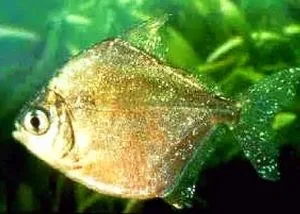
Indicated by a fine, gold or rust-colored film on the fish’s body, reminiscent of velvet. Infected fish may exhibit clamped fins, glancing off surfaces, and labored breathing.
Columnaris (Cotton Wool Disease): This bacterial infection can manifest as white, fluffy patches on the mouth, skin, and gills of fish. It can be acute or chronic, and swift isolation and treatment with antibacterial medicines in a hospital tank can prevent a widespread outbreak.
Fish display patchy white lesions on the mouth, gills, and skin, resembling cotton wool. There may be ulcers, loss of appetite, and abnormal swimming behaviors.
Dropsy: Indicated by a swollen body and raised scales, dropsy is a symptom of a bacterial infection that affects the kidneys, leading to fluid accumulation. The condition is often fatal, and affected fish should be quarantined to prevent stress to other fish and to attempt treatment.
Symptoms include a severely swollen abdomen, scales sticking out like pine cones, and sometimes red streaks in the fin areas. Fish with dropsy may also exhibit lethargy and a loss of appetite.
Pop-Eye: This condition, where one or both eyes bulge out, is typically a sign of a bacterial infection or injury. Treatment in a hospital tank allows for controlled dosing of antibiotics and reduces the risk of transmitting the infection to other fish.
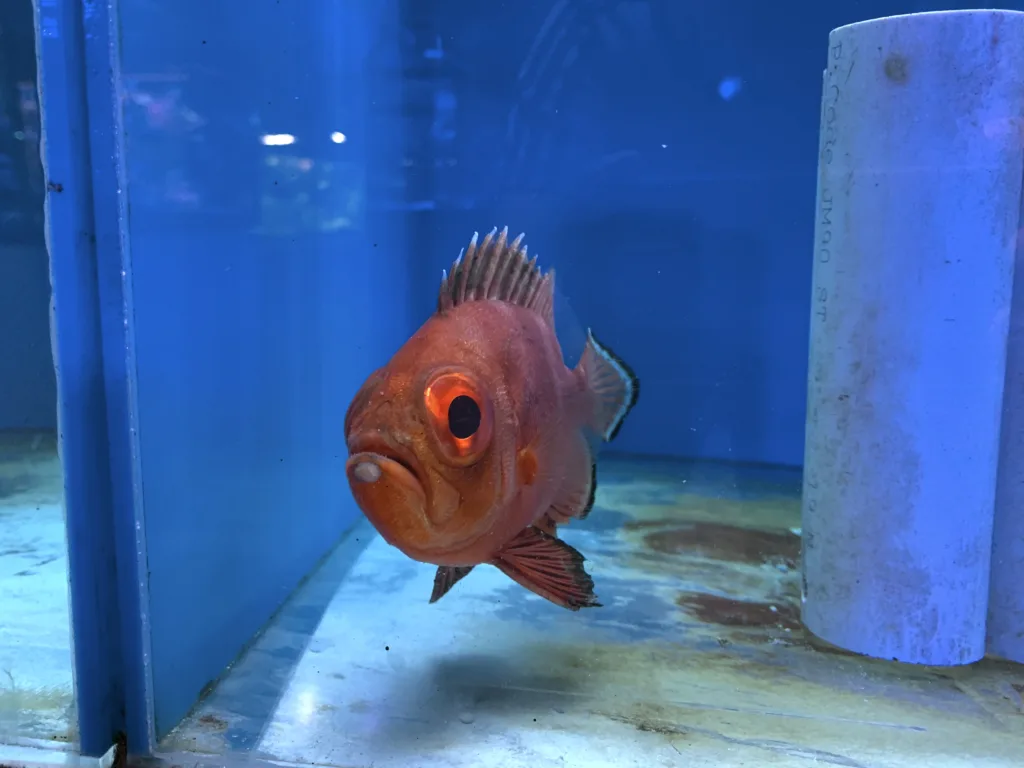
The most obvious sign is one or both eyes protruding abnormally. Accompanying signs might include cloudiness or hemorrhaging in the eye, and a general pallor in body coloration.
Fungal Infections: These appear as white or grayish fluffy growths on the skin, fins, or gills of fish. Fungal spores are ubiquitous in aquarium water, and a hospital tank allows for treatment with antifungal agents without affecting the main tank’s ecosystem.
Hexamita: Often affecting cichlids, this parasitic disease causes weight loss, color fading, and fecal changes. It’s best treated in a hospital tank with metronidazole, which can negatively impact the beneficial bacteria in a main tank.
Setting Up the Hospital Tank
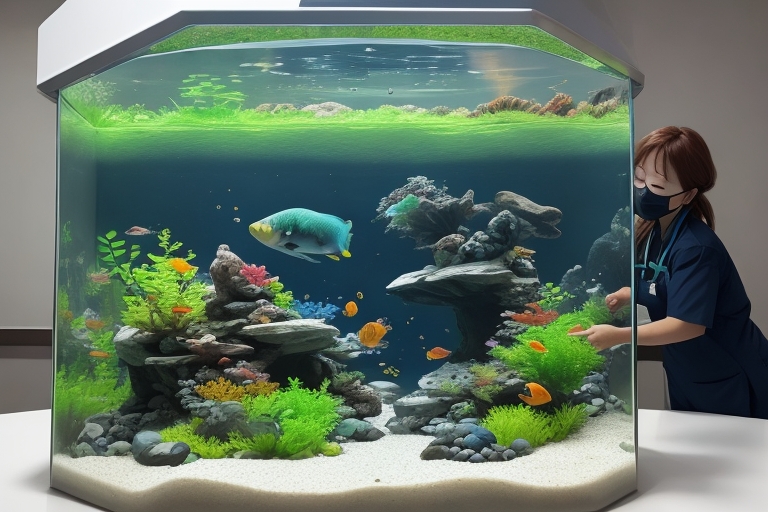
You can set up a hospital tank easily, but you need to ensure it mimics the main tank conditions. To start, use a separate tank for sick fish and ensure there’s adequate hospital tank lighting, a hospital tank heater, and a gentle filter, such as a sponge filter. Regular water changes are required to maintain good water quality, and medications can be used to treat diseases as needed. When setting up a hospital fish tank, make sure to use a bare-bottom tank for easy cleaning. Additionally, it’s important to keep the temperature and water parameters stable.
Finally, it’s important to clean and sanitize the hospital tank after each use to prevent disease spread. This includes wiping down the surfaces, replacing filter media, and changing out the water. If you follow these steps to create a hospital tank and maintain it properly, it will help ensure your fish stay healthy.
The benefits of a hospital tank, such as halting disease spread, individualized treatment, and protection from bullying, make it a crucial addition for any aquarium hobbyist.
Maintaining Stable Conditions
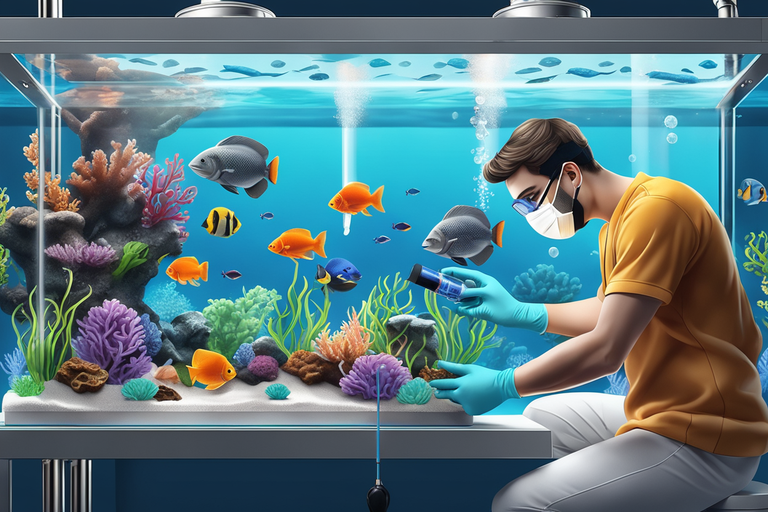
To ensure the best possible care for your fish, it’s important to maintain stable conditions in your hospital tank, so that the fish can receive individualized treatment. To do that, you need to focus on the following areas:
- Oxygen Levels: Air stones, oxygen pumps and powerheads can help maintain the correct oxygen levels.
- Ammonia and Nitrate Levels: A filtration system is necessary to keep the ammonia and nitrate levels in check. Regular water changes are also important.
- pH Levels: The tank size and water chemistry should be monitored to ensure the pH levels are stable.
In addition, you should pay attention to temperature control, UV sterilizers, and other water parameters. All of these will help you maintain a healthy environment for your fish.
The hospital tank should also be the right size, with enough space for the fish to swim and rest comfortably.
Finally, make sure to clean and sanitize the tank after each use, to prevent disease spread.
Overall, setting up and maintaining a functioning hospital tank is essential for aquarium hobbyists to keep their fish healthy. By taking the time to set up a hospital tank and ensure stable conditions, you can provide your fish with the best possible care.
Filtration for the Hospital Tank
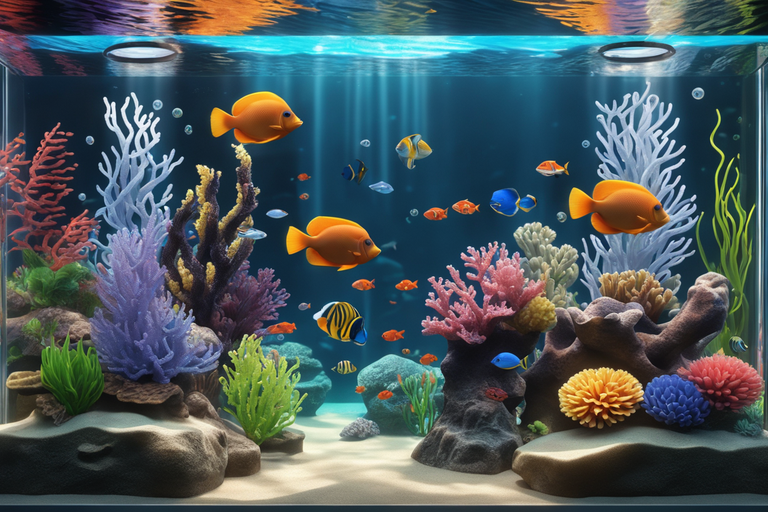
For a hospital tank, filtration is paramount, and while a sponge filter is often touted as the optimal choice, an undergravel filter can also serve as an effective alternative. A robust filtration system is indispensable to sustain water quality and furnish a protective refuge for ailing fish. By embracing apt fish tank isolation techniques and implementing precise filtration methods, you can inhibit the contagion of diseases in a hospital tank.
When organasing a transitory fish infirmary, selecting the appropriate aquarium equipment is vital. This encompasses a sponge filter, known for its gentle filtration, and an undergravel filter which, when paired with the right substrate, can effectively boost oxygen levels and foster beneficial bacterial growth. Both of these filters can aid in managing stress levels within a fish hospital tank.
In the process of establishing a quarantine tank for infirm fish, it becomes imperative to emulate the primary tank’s ambiance. This encapsulates both the temperature and water quality parameters. Periodic water changes stand as a cornerstone for preserving water quality. Additionally, it’s advantageous to retain the tank’s bare-bottom design to facilitate uncomplicated cleaning. Post-treatment, ensure that the hospital tank undergoes rigorous cleaning and sanitization to prep for future contingencies.
Integral to the regimen of best practices for a fish hospital tank is the continuous surveillance of the indisposed fish and swift medical intervention.
The inception and upkeep of an operational hospital tank are non-negotiable for aquarium enthusiasts desiring the wellness of their aquatic companions. By adhering to the gold standard in fish tank isolation techniques and electing the fitting equipment – whether it’s a sponge or undergravel filter – you can sculpt a sanctuary for sick fish, thwarting the proliferation of ailments in a hospital setting. Through rigorous filtration processes and water quality oversight, the recuperation and vitality of your fish can be assured.
Reintroducing Fish to the Main Tank
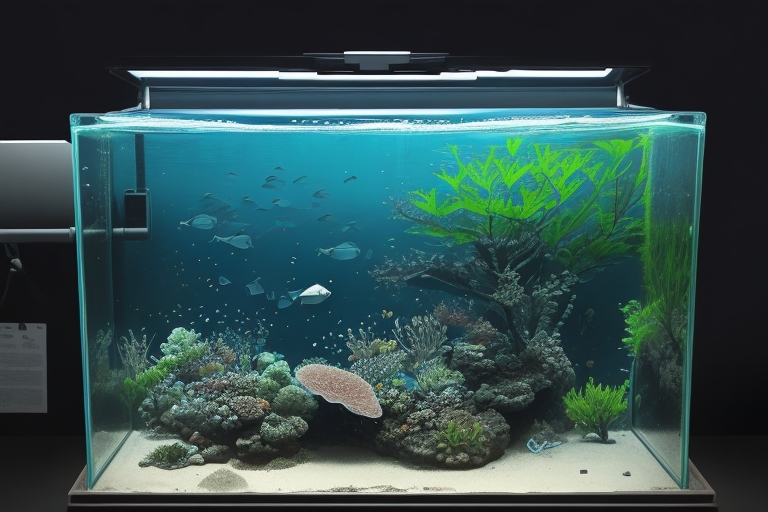
Once fish have recovered, you’ll need to reintroduce them to the main tank carefully. To ensure the fish stay healthy, it’s important to follow a few steps to make sure the transition is as stress-free as possible. Here are some tips to keep in mind:
- Medication: If the fish has been treated with medication, you’ll need to make sure the medication has been cleared before reintroducing the fish to the main tank.
- Water Parameters: Ensure the water parameters such as salinity and temparature in the hospital tank are the same as the main tank before introducing the fish.
- Bare-Bottom Tank: To make the transition easier, it’s best to keep the hospital tank bare-bottom as this will prevent the fish from getting stressed.
- Therapeutic Treatments: If you have been administering any therapeutic treatments, such as UV light, you should stop these treatments before introducing the fish to the main tank.
- Disease Prevention: To prevent the spread of disease, make sure to use separate equipment for the hospital tank and the main tank.
- Fish Stress: Give the fish a safe and healing environment before reintroducing them to the main tank. This will reduce stress and improve the chances of a successful transition.
- Acclimation Process: Once you’ve prepared the environment, you can start the acclimation process. This will help the fish slowly adjust to the new environment and prevent them from getting stressed.
Cleaning and Sanitizing the Hospital Tank
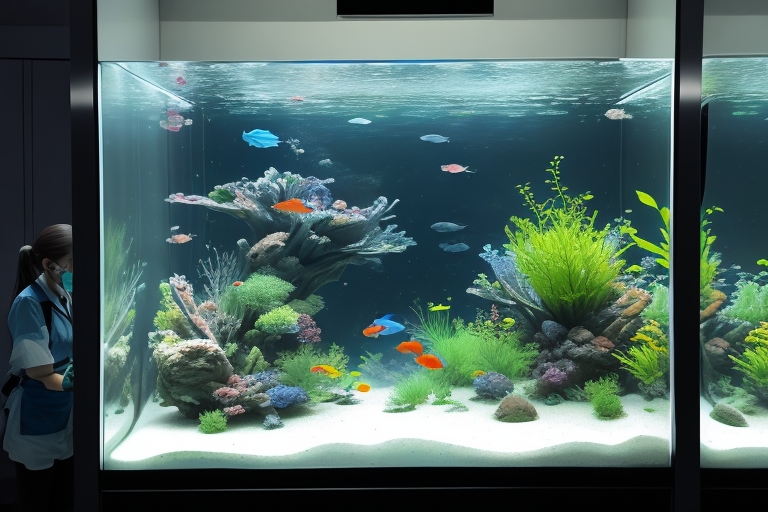
Your hospital tank needs to be cleaned and sanitized after each use to prevent disease spread. Fish species need to be monitored for disease symptoms and moved to an isolation tank as soon as possible.
Disinfecting tools, such as a bleach solution, should be used to clean and rinse the hospital tank and its contents. Neutral decor should be used in the hospital tank for easy cleaning, and filtration systems should be set up to maintain stable water quality.
When designing a quarantine fish tank, acclimating fish to the hospital tank is essential for their recovery. Caring for sick fish in a hospital tank requires individualized treatment and protection from bullying. Regular water changes should be done to maintain water quality, especially without chemical filtration.
After use, ensure fish have time to recover before reintroducing them into the main tank. Cleaning and sanitizing the hospital tank after each use is crucial to prevent disease spread and improve fish recovery chances.
Frequently Asked Questions
How Often Should I Change the Water in the Hospital Tank?
You should change the water in the hospital tank regularly, at least every week or two. Doing so will help maintain water quality and protect your fish from illnesses.
What Type of Fish Should I Put in the Hospital Tank?
You should only put sick fish in the hospital tank. Keep healthy fish in the main tank to prevent disease spread. Monitor the sick fish closely and treat them with individualized care.
How Do I Know if My Fish Is Sick?
If your fish is exhibiting signs of illness such as lethargy, unusual behavior, abnormal breathing, or changes in appearance, it’s likely sick and needs treatment. Monitor your fish regularly and seek medical advice if you’re unsure.
Can I Use a Chemical Filter in the Hospital Tank?
No, chemical filters should not be used in a hospital tank. It’s important to maintain stable water quality and temperature, and chemical filters can disrupt this balance. Sponge filters are recommended for gentle filtration. Regular water changes are also necessary.
How Long Should I Keep Fish in the Hospital Tank?
You should keep fish in the hospital tank until they have fully recovered. Monitor water quality and temperature, and perform regular water changes. Be sure to clean and sanitize the tank between uses, and give fish time to rest before reintroducing them into the main tank.
Establishing a hospital tank for your aquarium is a great way to keep your fish healthy and thriving. With the right equipment and regular maintenance, you can create a safe and healthy environment for your fish.
With a hospital tank, you can isolate sick fish, provide individualized treatment, protect healthy fish from potential bullies, and make your aquarium maintenance easier.
With the information provided in this guide, you have everything you need to set up and maintain a hospital tank for your fish.

